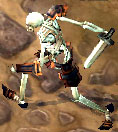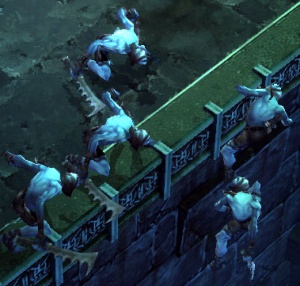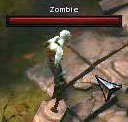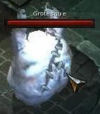Undead are one of the three classifications of monsters in Diablo II. All monsters belong to one of the classifications in Diablo II, and certain spells or items are more effective against different types of monsters.
It's not known if these classifications will return in Diablo III, but we're using it since it's a convenient way to sort things, until official information is released.
The three classifications of monsters we use in Diablo III are:
- Animals - Feral, unintelligent enemies.
- Demons - Mostly Sinister, sentient monsters from Hell.
- Objects - Stationary obstacles, like traps.
- Undead - Varying types of re-animated corpses, mostly from humans.
For a full list of Undead monsters, check out the Undead Category. You can also go to the Diablo 2 Wiki to the find Diablo 2 Undead.
Contents
Undead
The Undead classification is for several types of corpse or skeleton reanimation. A Witch Doctor is capable of summoning undead monsters to help him in battle, but mostly it refers to enemies of the player. The undead monsters vary greatly in appearance and intelligence.
The demonic undead belong to the realm of influence of Mephisto, who specializes in perverting the dead into macabre creations of undeath.
Skeletal Types

There are also truly powerful skeletal undead, like King Leoric, which is infused by the power of his tormented soul in addition to dark magic.
Corpse Types

Ghouls
Ghouls are some sort of reanimated corpse but nothing like slow shambling zombies; the ghouls are fast and uncanny, running hunched over in a bestial, almost quadrupedal style. They climb quickly and leap out at the player from all angles, scaling a huge wall to get into the action. They seem somewhat intelligent in that they can also wield weapons, such as swords.
Zombies

Mummies
Mummies are usually powerful warriors or kings stored in great tombs of the Sanctuary desert tombs, and when reanimated, they will react similar to Zombies. The difference is their power and capabilities of spreading disease easier. No mummy type enemies have been announced for Diablo III yet.
Construct Types

Incorporeal Types
A great deal of undead comes in incorporeal forms, such as Wraiths. This type of undead is the ectoplasmic manifestation of a soul that chose to stay in the mortal realm after losing its normal life, a spirit that has been forced to stay through magic, or perhaps pulled in to the mortal realm from the spirit world. Depending on the type, they usually require weapons of magical nature to damage, and they are experts in draining speed, energy or health from anyone that would have a close encounter with them.
Higher Undead
Most general types of undead never reach a point where they are truly sentient, and even then, they are usually slaves to some sort of master that resurrected them. However, if enough dark magical power is infused in a corpse, skeleton or a skeletal construct, they can attain sentience, and even outdo their former master. Examples of this is classically Liches or Vampires, who often in turn raise lower undead as servants and guards.
Besides King Leoric, no other "Higher" undead has been announced for Diablo 3.